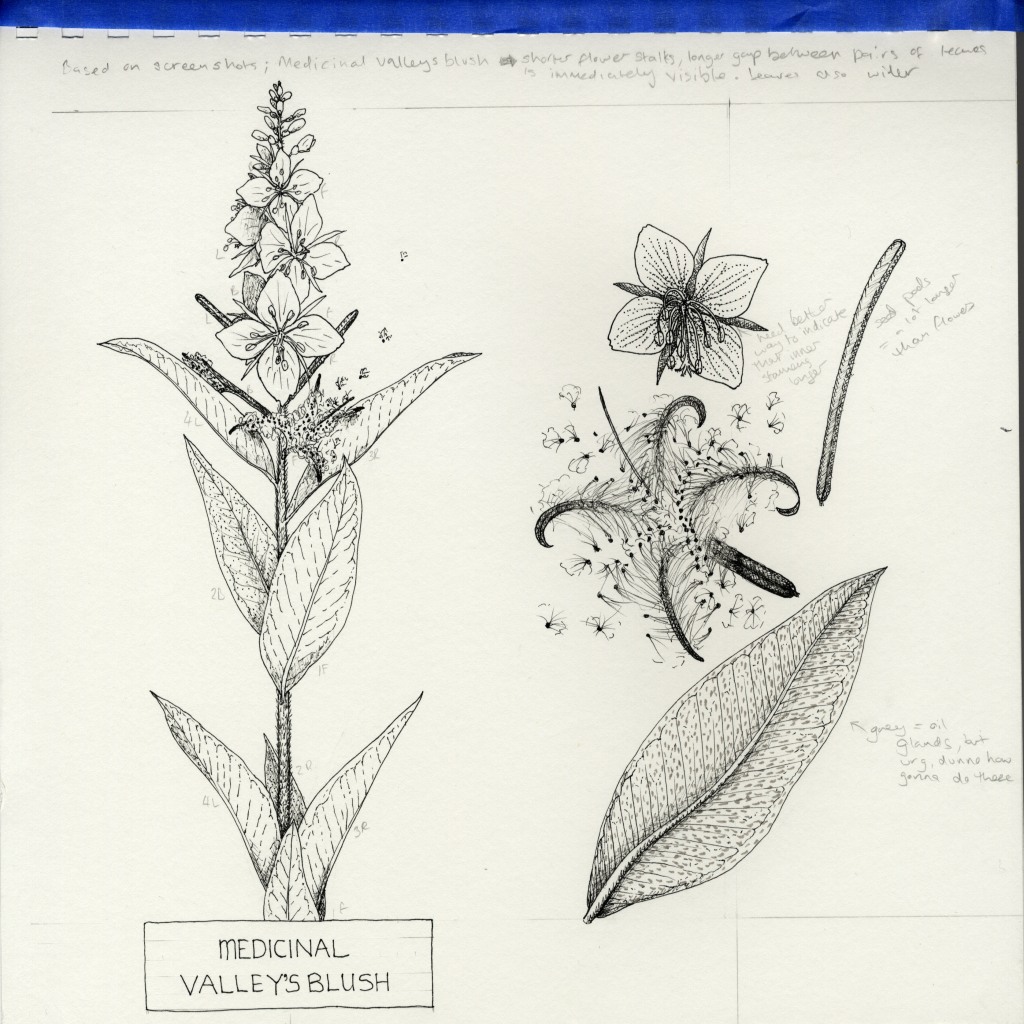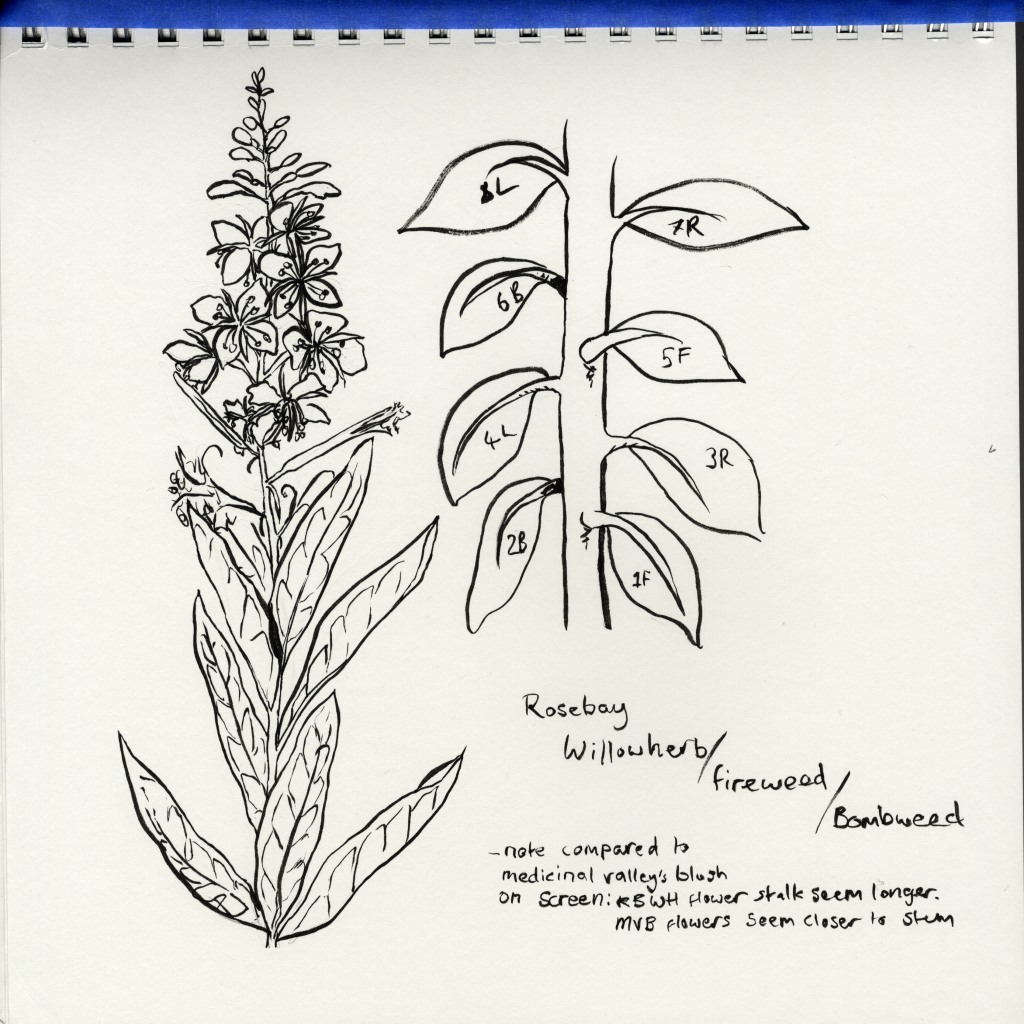The jump from botanical description to field notes was possibly the hardest part for me. The Nora tribe, described in Immy’s blog, are a pre-industrial group with hunter-gatherer traits. What I wanted to focus on was their connection to the natural world and their in-depth expertise on their surroundings. Their survival depended on it, and therefore their knowledge had to be extensive and precise.
Although I appreciate that we have no evidence of written records produced by the Nora, the whole premise of this collaboration was that written records exist – otherwise no field notes… The Nora collector of my imagination decided to make these notes not just for themselves but for others. Part aide-memoire, part teaching guide. We know from the game that extensive knowledge is passed down from generation to generation – orally mostly but there we are – and I wanted these notes to play a part in this. I also did not want to lose out on botanical accuracy by not using scientific terms. Sure, acropetalous is a very specific term in botany that describes exactly what I have in mind, but it is not necessarily irreplaceable in field notes. As long as the traits are described in some way then all is well.

My focus for the notes followed two questions: “how do you tell the plant apart” and “what can you do with it”. The first part was relatively easily extracted from my botanical description. The second needed a bit more thought.
I say “relatively easy” but I’m lying… My PhD, for those of you fortunate not to know, is on botanical morphometrics. This means I feel very attached to measurements. And I found myself having absolutely no knowledge of how the Nora measure length and distances whatsoever. This made me rather unhappy. More than I’d like to admit. How far is the nearest population from Mother’s Heart? Is that in feet? Yards? Paces? Watcher’s lengths? How tall is the plant on average? Is it in relation to the height of a grown woman? I believe that the Nora had some sort of standardised measures used to communicate. They must have. But all I knew of were temporal measures of distance of the “three days journey north” kind. In the end I went for the cop-out option of trying to avoid it as much as possible, but if I’m honest I am contemplating what standardised measures the Nora would use, and I think I would like to develop them during the course of this project. Stay tuned for that part…

For usage notes I had two different sources of inspiration. First there were the actual uses of what I believe was the inspiration for Medicinal Valley’s Blush – willowherb. Willowherb has a variety of uses from culinary to medicinal, so there was plenty material there. But I also had the game to consider. The designers occasionally gave the leaves a slight striated look, and I also had the fact that in-game it could restore about an eighth of Aloy’s health. That’s when I decided to make the striation be the result of surface glands. My idea was that a plant that could increase health to that degree needed some sort of specific attribute for it. The epidermal glands were my solution to this. In my (admittedly overactive) imagination, for a plant to actively give you back over 10% of your health it needed to be producing just the right compounds. In general, plants can do this in many ways, but I am a Mediterranean botanist and I can never quite escape this – in Mediterranean many plants produce aromatic compounds for a variety of reasons using glands on the surface of the leaf. Think of lavender and rosemary. I feel a little bit like Immy here, inserting insects just because they can… In my case I insert Mediterranean botanical characteristics… And so epidermal glands are now present, shaped like double pointed ovals just to create a bit of stripy look on the leaves, and to produce compounds that can heal to a substantial degree.
Below is the draft to my field notes. I hope they don’t trivialise the expertise of the Nora and demonstrate their in-depth understanding. I also hope I lined up their usage well with what we observe in-game. I also made it a bit laxative. Because I could. No other reason. No regrets.
EOWTFIC002418
Medicinal Valley’s Blush
Look for:
- Leaves with pointed oval glands
- Hairy stem
- Spiral arrangement of leaves and flowers
- Flowers in 4s, clay coloured
Always keep a stock.
Habitat: Commonly found in areas of recent disturbance. One of the first plants to emerge after a fire, possibly due to the protection offered by its root structure and the large distance travelled by its seeds. Resilient to a wide range of weather conditions, making it prevalent throughout the Sacred Land. Usually surrounded by grasses and small shrubs, less commonly found in open forests.
Size: From just below the knee to up to the height of a grown woman. It usually does not reach its full size due to accidental damage from machines.
Type: Perennial herb
Stem: Single stem with no branching. Bright green when young but darkens as it ages. Covered in soft white hairs.
Leaves: Lance-shaped leaves that grow in a spiral. They lack stems and feel slightly leathery. When crushed they are subtly aromatic – a bit like mint. Covered in pointed-oval white glands creating a slight striped pattern. Gland shape clearly visible under a Watcher lens. Veins often join at leaf edge.
Flower: Spirally arranged, on top part of stem. Usually around 20 flowers per plant but occasionally up to 30. Flowering in sequence with lower ones opening first. Each flower has parts in 4s. The four petals are mostly symmetrical, although often the lower two are slightly larger. Petal colour from pink at base to clay red at tips. Stamens in two whorls of 4.
Fruit: A capsule. Seeds very small and wind dispersed.
Uses: Young leaves sweet with a slight bitter aftertaste. Not poisonous in regular quantities although may have a laxative effect if too much is ingested. Very young leaves can be eaten raw as a salad. Older leaves, stems, and root can be baked and added to meals for fibre and flavour. Leaves of all ages can be brewed for tea to treat digestive discomfort. Root can be crushed into a powder and placed on minor to moderate wounds to speed up healing. A good herb to keep in medicine pouch when travelling.
Note: A large population was recorded around 200 steps on the north road from Mother’s Heart.